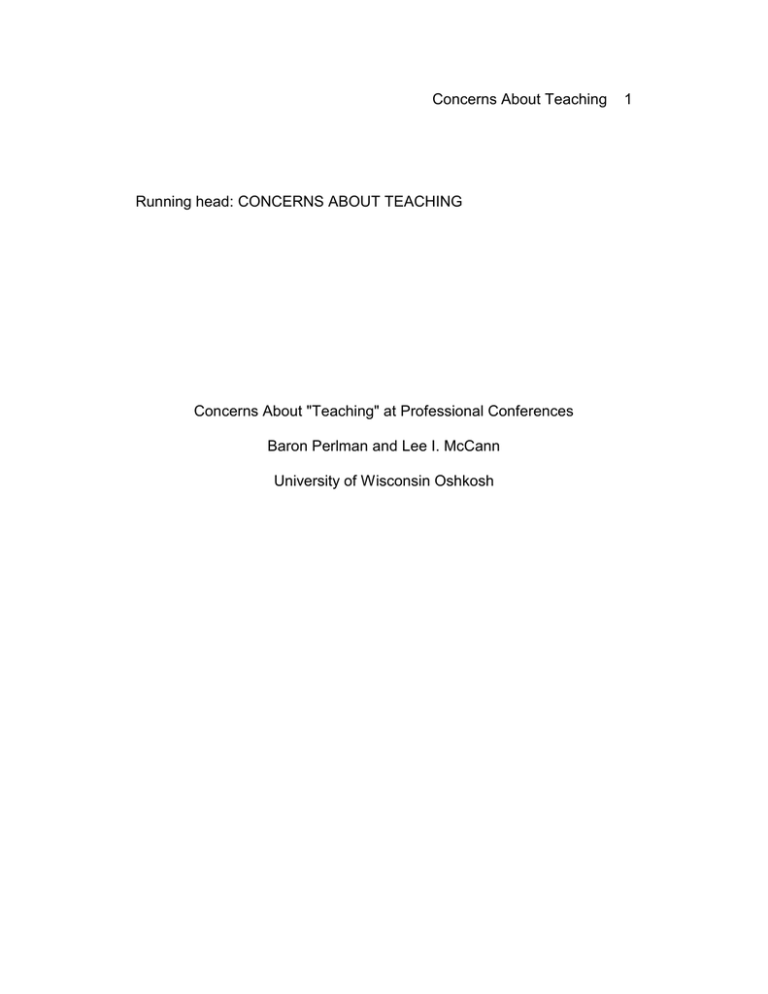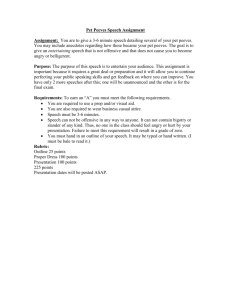Concerns About Teaching 1
advertisement

Concerns About Teaching Running head: CONCERNS ABOUT TEACHING Concerns About "Teaching" at Professional Conferences Baron Perlman and Lee I. McCann University of Wisconsin Oshkosh 1 Concerns About Teaching Abstract Faculty, as "students," at professional meetings, expect high quality "teaching." We obtained their peeves about the "teaching" they received at conferences and found concerns across the teaching spectrum. These concerns can serve as guidelines for presenters to improve the quality of their presentations and pedagogy. 2 Concerns About Teaching 3 Concerns About "Teaching" at Professional Conferences Most efforts to improve teaching involve undergraduate and graduate instruction. But other pedagogy, largely ignored in the literature, occurs when we teach and learn at professional meetings and conferences. How might this teaching be improved? Brookfield (1995) argues that we do not really understand the outcome and impact of our teaching, nor how to improve it, until we ask students how they perceive our pedagogy. Asking undergraduate students their pet peeves about faculty teaching is one example (e.g., Perlman & McCann, 1998). We used this technique with faculty in the role of "student" attendees at professional psychology forums. Their opinions should prove useful for any presenter interested in enhancing the quality of their conference "teaching." Method Participants We surveyed attendees at a state (N = 29, response rate = 100%), regional (N = 78, response rate = 63%), and national (N = 400, response rate = 12%) teaching conference and colleagues at two doctoral and two master's departments (N = 18). One hundred forty-one responded; 134 contributed usable data. Procedure All attendees responded individually during one session at the state Concerns About Teaching 4 teaching conference. At the regional meeting we distributed a brief questionnaire to all participants to be completed and returned before the conference ended. At the national meeting an announcement indicated a questionnaire was available at the registration desk and could be returned there. We also distributed questionnaires to faculty in our own department and asked colleagues to do the same in three other departments. Potential participants were told: "We are interested in the quality of teaching that takes place at conferences. What are your pet peeves (major dislikes and annoyances) about conference workshops, symposia and other presentations you have attended over the past few years (e.g., APA, APS, NITOP). Take a few minutes and write down your two or three major pet peeves about such presentations. What bothers you or annoys you the most?" Results and Discussion Respondents provided an average of 2.0 pet peeves (SD = 0.70, Median and Mode = 2). Table 1 categorizes 265 responses in four categories: preparation and content, style and rapport, managing time/ audience/questions/interchange, and visual aids. The six most frequently listed concerns fall across all four categories: poor rapport with audience (n = 33, 12%), illegible visual aids (n = 30, 11%), presentation too long or starting late (n = 21, 8%), disorganized presentation (n = 21, 8%), lack of congruence between titles/abstracts and content presented (n = 19, 7%), Concerns About Teaching 5 and little or no time for questions/interchange (n = 19, 7%). Balance seems important. Attendees complained about both too much and too little material, some audience members monopolizing or too little opportunity to participate, and so forth. Preparation and practice are important as few presentations exceed one hour, and there is little if any opportunity to correct deficiencies, a process we call "one trial teaching." We recommend that conference "teachers" keep in mind that attendees have often traveled long distances to hear them, often choosing not to attend attractive concurrent sessions. In looking at many of the concerns, we conclude that "less may be more." Attendees can always read in depth, contact presenters, and continue their learning after the conference. First, however, they need a clear, concise presentation of the important issues, and they expect to obtain this through quality teaching at the meetings they attend. Concerns About Teaching References Brookfield, S. D. (1995). Becoming a critically reflective teacher. San Francisco: Jossey-Bass. Perlman, B., & McCann, L. I. (1998). Students' pet peeves about teaching. Teaching of Psychology, 28, 201-203. 6 Concerns About Teaching 7 Notes 1. We acknowledge the assistance of conference attendees and our colleagues. This article is based on a poster to be presented at the 2002 Annual National Institute on the Teaching of Psychology, St. Petersburg Beach, FL. 2. Address correspondence to Baron Perlman, Department of Psychology, University of Wisconsin Oshkosh, Oshkosh, WI 54901; e-mail: Perlman@uwosh.edu. Concerns About Teaching 8 Table 1 Audience Pet Peeves About Conference Presentations __________________________________________________________ Na %b__ or content integration, no take home message) 21 8 Title/Abstract do not accurately describe content 19 7 17 6 16 6 Handouts (e.g., too few, incomplete, irrelevant) 14 5 Unprepared presenter/discussant 10 4 8 3 105 40 33 12 ___________________________________________ Preparation and Content Disorganized (e.g., no outline or summary, no themes Lack of content (e.g., too much intro/small talk, audience generates content, use of icebreakers) Content choice (e.g., too high/low or technical, expert does not share expertise, lack of depth, conclusions not supported by data, no theory, too theoretical, no examples ) Too much material Total Style and Rapport Poor rapport with audience (e.g., reading verbatim) (table continues) Concerns About Teaching 9 __________________________________________________________ Na ___________________________________________ %b__ Speaking style (e.g., monotone voice, boring, no enthusiasm, no humor, talks too fast or slowly) 18 7 Lack of respect (e.g., pompous, arrogant, talk down to audience, not approachable, do not send promised materials after conference) 8 3 59 22 Run too long, start late 21 8 No/little time for questions or interchange 19 7 11 4 Total Managing Time/Audience/Questions/Interchange Not managing audience well (e.g., audience "experts" pontificate, muddy issues, audience comments take too much time) Not repeating inaudible questions Total 3 1 54 20 30 11 Too much on overheads/slides/PowerPoint 8 3 PowerPoint: too fancy, distracting 5 2 Other (e.g., no visual aids, struggle to use technology) 4 2 Visual Aids Illegible (e.g., print too small) (table continues) Concerns About Teaching 10 __________________________________________________________ ___________________________________________ Total Total Na %b__ 47 18 265c ______________________________________________________________________________________ a Attendees (n = 134) usually gave more than one peeve per category. Responses represent number of peeves, not attendees. b Percent = number of responses/total number given. c Total percentage may not equal sum of item percentages due to rounding.



